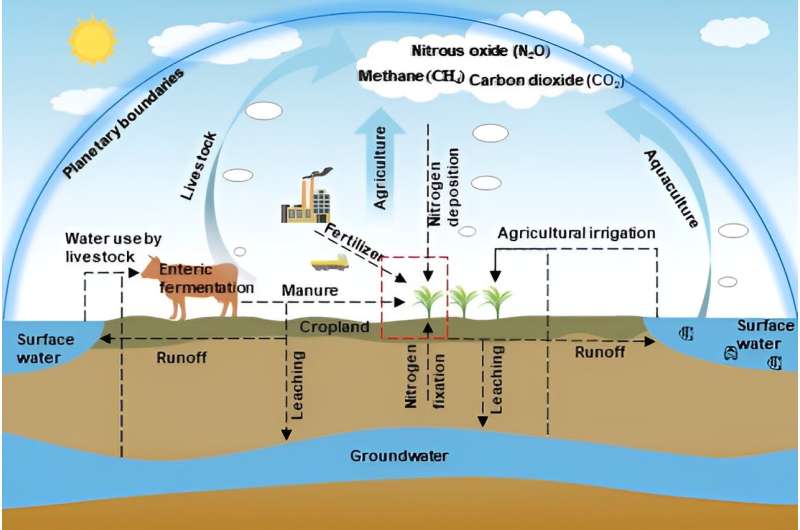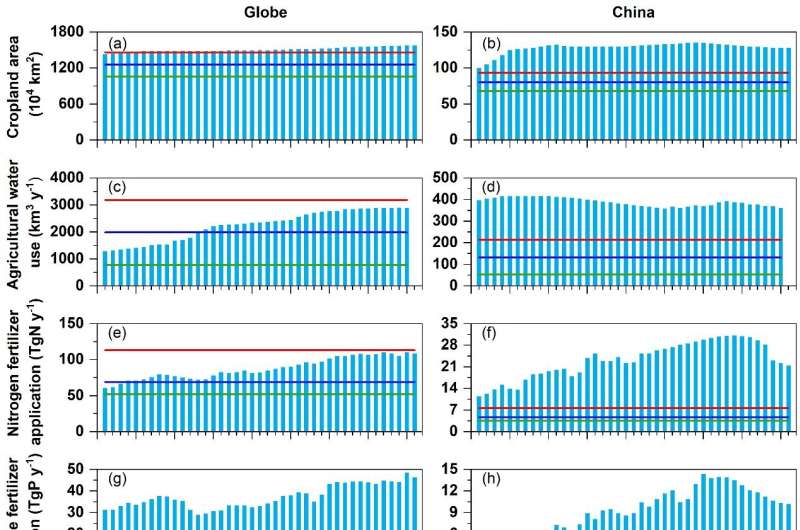This article has been reviewed according to Science X's editorial process and policies. Editors have highlighted the following attributes while ensuring the content's credibility:
fact-checked
trusted source
proofread
Assessment and strategies for sustainable food systems within planetary boundaries

Since the Green Revolution in the 1960s, intensive agricultural production practices have laid the foundation for food security. However, these measures are also accompanied by significant resource input and environmental impacts. Meeting the increasing food demand in a sustainable manner becomes a global challenge.
Defining sustainable thresholds for resource use and environmental impacts is crucial for achieving sustainable development of the food system. The conceptual framework of planetary boundaries (PBs), introduced in 2009, has emerged as a crucial reference in the study of sustainable food systems.
Dr. Wenjiao Shi (Institute of Geographic Sciences and Natural Resources Research, Chinese Academy of Sciences) and the co-authors conducted a systematic overview of the application of PBs in food systems. Their research is published in the journal Science China Earth Sciences.
The food system significantly contributes to exceeding global or regional PBs, posing significant threats to dimensions such as land use, freshwater use, N and P cycles, and climate change within the PBs framework. Since introducing the global PBs framework, scholars worldwide have conducted extensive research across various dimensions.
The results indicated that in the integrated assessment of food system-related PBs, the cropland boundary was 1260×104 km2; the freshwater boundary was 1980 km3/y, accounting for about 70.71% of the total global freshwater boundary; the nitrogen and phosphorus fertilizer boundaries were 69 TgN/y and 16 TgP/y, respectively; and the boundaries of the total greenhouse gas (GHG) emissions from agricultural production and non-CO2 GHG emissions were 6.5 GtCO2eq/y and 4.3–5.3 GtCO2eq/y, respectively.
The original purpose of PBs was to offer a global perspective and was not initially intended for regional-scale applications. However, since sustainable management strategies related to resources and the environment are formulated at the regional scale, downscaled applications of PBs are necessary.
Current downscaling methods can be broadly categorized into "top-down allocation" and "bottom-up integration" approaches. Based on the two methods, the cropland boundary in China's food system was determined to be 80×104 km2, the freshwater boundary was 53 km3/y, the boundary of nitrogen and phosphorus emissions from water bodies was 0.58 TgN/y and 0.32 TgP/y, and the boundary of GHG emissions from agriculture was 0.97 GtCO2eq/y, in the light of China's regional freshwater availability and population proportion.

The entire food system supply chain, including production, post-harvest handling and storage, processing, distribution, retailing and consumption, puts pressure on resources and the environment. This study explored the evolving trends of different indicators related to resource use and environmental impacts in the global and Chinese food systems since 1981 and systematically compared these gaps between them and the PBs associated with the food system.
The results indicated that the global cropland area has already surpassed the upper boundary of 120×104 km2. In addition, agricultural water use has increased by 124.35% over the past 40 years, nearly reaching the upper boundary.
From 1961 to 2020, global total N and P applications increased by 5.7 times and 3.0 times, respectively, and have exceeded the mean boundary. The current N and P losses in the food system were 2.5 times and 0.85 times the corresponding mean boundary. The total emissions still account for about one-third of total anthropogenic GHG emissions and have already exceeded the lower boundary of GHG emissions.
In China, the total cropland area has exceeded the upper boundary of 35×104 km2, and the freshwater use in the food system has exceeded the upper boundary of national freshwater use of 64.8%.
In 2021, the total amount of N and P fertilizer applied were 1.86 times and 3.48 times the levels in 1981, respectively, both greatly exceeding the upper boundary. In addition, China's food system contributes significantly to total GHG emissions, approaching the lower boundary of GHG emissions.
Implementing sustainable management strategies at the global or national level is vital for achieving the targets of resource and environmental sustainability within the food system. Existing management strategies mainly include dietary changes, improvements in technologies and management, reductions in food loss and waste, optimization in agricultural production distribution, and combined strategies.
Finally, several suggestions are proposed to enhance future research on sustainable food systems within the PBs framework in the following aspects: (1) enhancing research on the interaction mechanisms among PBs in the food system; (2) strengthening the downscaling research of PBs within the food system; and (3) improving the rationality of policy-making for the sustainable food system in China.
More information: Minglei Wang et al, Research progress in assessment and strategies for sustainable food system within planetary boundaries, Science China Earth Sciences (2024). DOI: 10.1007/s11430-023-1232-y
Provided by Science China Press




















